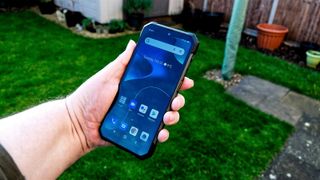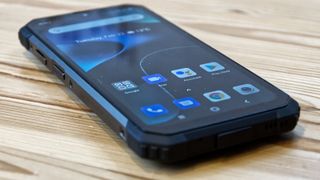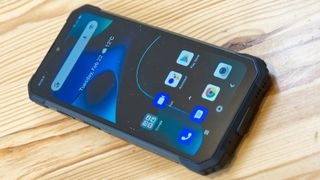TechRadar Verdict
A well-made ruggedized design undermined by its inability to present better than 480p streamed content or capture video in 4K. Without 5G technology, this design might struggle to sell in countries with that service.
Pros
- +
Great value for money
- +
Night vision camera
- +
Excellent battery life
- +
90Hz Refresh Rate Display
Cons
- -
Widevine L3
- -
Heavy
- -
Forked OS
Why you can trust TechRadar
Blackview is one of many Chinese phone makers that have specialised in rugged designs, including market leaders, Doogee and Oukitel.
In our experience, Blackview usually has the edge over its competitors on style and price and can be an excellent choice for those that need a rugged design for a specific short-term project.
Historically this maker has had weaknesses with Android OS implementations and the quality of some components, often using cheaper screens.
The BV8800 reviewed here is a rung down from their flagship BV9900 Pro design but includes many features that other brands reserve for their top specification phones.
It can be bought directly from the maker for under $300, making it one of the cheaper IP68/ IP69K designs.
Is the BV8800 a bargain, or has cost-cutting taken away things buyers might want?

Price
Blackview lists all its phones with an MSRP value that they presumably launched and a price they’re offering them for now. We can’t say if these products ever sold at a higher price, but we can say that the BV8800 is very competitive for a device of this specification.
Direct from Blackview, the BV8800 is £220.76 ($299.99), and that includes free 7-20 day shipping, or you can have it come quicker via DHL for an additional $20.
The BV8800 will initially ship on the 7th March 2022, but you can pre-order it now in three different colours (Orange, Black and Green).

Design
Blackview didn’t make any other design statement with the BV8800 other than parading its toughness and ability to handle challenging environments. The shape avoids sharp edges has angled corners, and a gently curving underside.
Comfortable in hand, it has a very natural shape for a right-handed user with the side-mounted fingerprint sensor (and power button) automatically aligning with the thumb.
The curved underside hints that this phone doesn’t support wireless charging, a feature many of the recent Doogee designs include.
Without this capability, you must charge using the USB-C port that is kept water-resistant with a rubber plug that gets in the way of cable insertion. Doogee had the same issue with this port, and it’s something most rugged designs need to address.

The rest of the BV8800 is very much a rugged smartphone by the numbers, delivering well-specified dust and water-resistant Android device could double as a blunt instrument.
With a 6.58" IPS screen and a weight of 365g, this isn’t a phone that easily fits in a pocket and is heavy enough to require properly securing when used in a vehicle.
Easily the most eye-catching feature of the V20 is the wonderfully colourful OLED display with a natural resolution of 1080 x 2400. The contrast ratio on this screen is an incredible 80000:1 and displays 105% of the NTSC colour gamut.
One peculiarity with the screen is that to get the biggest vertical display coverage, the front-facing camera is under the display, and a small hole has been cut through it. Not exceptional, but it's something you might not expect to see when viewing a video full screen.

Hardware
The Blackview BV8800 that was sent to us for review came with the following hardware:
CPU: MediaTek Helio G96 MT6781 Octa Core 2.05 GHz
GPU: ARM Mail-G57 MC2 @850 MHz
RAM: 8GB LPDDR4X
Storage: 128GB
Screen: 6.58" IPS TFT
Resolution: 1080 x 2408
SIM: Dual Nano with Standby (no MicroSD)
Weight: 365g
Dimensions: 170.2 x 83.5 x 17.7 mm
Rugged Spec: IP68, IP69K and MIL-STD-810H
Rear camera: Quad camera (50MP+20MP+8MP+2MP) with Night vision mode
Front camera: 16 MP
OS: Doke OS 3.0 (Android 11)
Battery: Li-Ion 8380 mAh
Unlike the early days of Android smartphones, even cheap devices have a powerful SoC at their heart, and the BV8800 uses a popular MediaTek chip.
The Helio G96, aka the MT6781, is an SoC launched in Q3 of 2021 and sports two Cortex-A76 2.05 GHz and six Cortex-A55 2.0 GHz cores, providing a balanced solution for both performance and power management.
The associate GPU is the 850 MHz Mali-G57 MC2. Included in the SoC is wireless technology with support for legacy phone protocols up to 4G, Dual 4G VoLTE, Bluetooth 5.2 and WiFi in 4x4 MIMO mode.
Memory is 2133 MHz LPDDR4X, 8GB in this model, and it comes with 128GB of flash storage, of which 113GB is available to users.
The screen uses IPS technology and has a slightly odd resolution of 2408 x 1080 giving it an unusual ratio of 20.1:9. The selling point of this display is that it has a screen refresh of 90Hz, which might be of interest to those that game on their phone.

For those interested in photography and video, the BV8800 has a centrally mounted cluster of four sensors, offering a wide range of capture options, including a monochrome night vision mode.
The cameras can capture some impressive images in all lighting conditions. However, using a Samsung S5KJN1 as the first sensor with 8160x6144 px, you are forced to enter a special 50MP mode to get this resolution. Inexplicably standard photos are limited to 4032 x 3024, and video is capped at 2560 x 1440.
The only upside to these limitations is that the zoom function has more lossless multipliers since the image shown represents only a fraction of the sensor.
Performance and in use
This is how the Blackview BV8800 performed in our suite of benchmark tests:
Geekbench: 515 (single core); 1780 (multi core)
PCMark (Work 3.0): 8913
Passmark: 8118
Passmark CPU: 3987
3DMark Slingshot: 3441 (OGL)
3DMark Slingshot Extreme: 2413 (OGL). 2289 (Vulkan)
Wild Life: 1098 (Vulkan)
HWBot Prime: 4934
While not as punchy as the MediaTek MT6833 on the Doogee S20, the MT6781 has acceptable performance when coupled with 8GB of RAM.
In a direct comparison with that other SoC, this one is between 2% and 5% slower across the board.
Where this design suffers a little is in 3DMark, where even older designs like the Huawei P30 Pro achieve Slingshot scores of 5,750 making this chip only about 60% of the performance of the KIRIN 980 SoC in that 2019 design.
What the BV8800 has is fine for most uses, but it isn’t going to embarrass the latest Samsung or Apple devices.
There is one place where the hardware in this phone is an issue, and that’s for those that like to stream content from Netflix, Amazon, or other providers. Like the Doogee S20, this phone doesn’t support any better than Widevine L3 stream certification, forcing content to be limited to 480p. Given the resolution of the screen, this restriction is disappointing.
We should also mention that Blackview has created a fork of Android 11 called Doke 3.0 for the BV8800. It’s so close to vanilla Android 11 with support for the Google Play Store, making it a mystery why Blackview felt it necessary to make Doke 3.0? Whatever the reasoning behind it, this might be an issue for some potential customers.
Where this phone shines most brightly is with battery life. With an ample Li-Ion 8380 mAh battery and the ability to charge rapidly using the provided 33W USB-C charger, the BV8800 can last 720 hours on standby and be fully recharged from drained in 90 minutes.











Final verdict
Yet another rugged phone with a high-resolution screen and great cameras but cannot record 4K video or playback streaming content in better than SD resolutions.
Many of the limitations of this design parallel those on the Doogee V20, and both these companies need to appreciate that for western purchasers watching Netflix might be important.
If it weren’t for these issues, we’d be more excited about a device this is well made, has a generally good feature set, and comes at a modest price.
Where it shines is multi-day operations without a recharge and prolonged life on standby.
The lack of 5G might also be an issue for some, but not all.
What initially looked like a bargain was a fair price for the BV8800. It is ideal if you need an Android phone that doesn’t mind rain and dust and are less keen on streaming, 5G and high-resolution video.
- Also check out our complete list of the best rugged smartphones
Mark is an expert on 3D printers, drones and phones. He also covers storage, including SSDs, NAS drives and portable hard drives. He started writing in 1986 and has contributed to MicroMart, PC Format, 3D World, among others.

